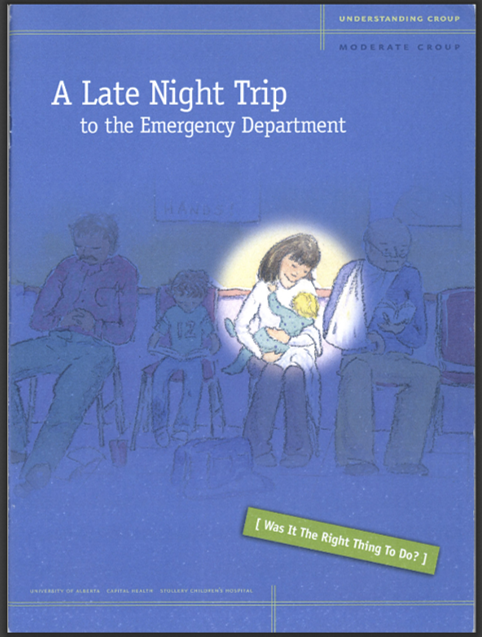Main Menu

It’s a noisy world, full of information, opinions, and voices. For those old enough to remember, a search for information used to involve going to a silent library and spending hours trying to find the right book, often without success. Indeed, the internet has been a wonder for those of us in the business of knowledge.
At the same time, with all of that noise, it’s becoming almost impossible to be heard. With crucial information that may better the health of patients, we as researchers and health professionals have important things to say. Still, how can anyone hear us much less remember what we’re saying through all of that racket? Today’s blog post is the first in a series discussing new and innovative ways to communicate your health evidence. In particular, it will focus on using graphic stories as a KT tool to communicate within the research community and to public audiences.

Graphic stories are simply two narratives, one verbal and one visual, combined to tell a story or relay information. Common formats include graphic novels and, comics, and cartoons. Communicating health information using this form of media is not new. In fact, it has been used for many years. However, many adult patients find it difficult to take comics seriously as comics are traditionally treated as just for kids, causing the healthcare community to be hesitant to use them as a mode of communicating important health information. However, the case for using graphic stories as KT tools is gaining momentum for several reasons.
The digital age is changing our reading habits from absorbing long sections of text to “skimming”. Consequently, new methods of communicating health information are needed if health researchers and practitioners want to create impact. Thus, converting health information into an engaging and visual story matches reading current reading habits better than text-centered brochures and guidelines. As a universal language, images are more easily understood by non-native speakers or individuals with low literacy. The combination of visuals with text also allows the information to be absorbed by the reader far more quickly and with less effort. This is because the visuals in the graphic narrative efficiently convey important social and emotional information that would otherwise require paragraphs of text. In this way, the graphic story can be very effective at tackling conditions that are often accompanied with complex social issues, such as mental illness and sexually transmitted infections.
“Graphic pathologies ” are an increasingly popular form of graphic stories in KT. Graphic pathologies present stories of patients, or their caregivers, as they experience a serious illness. These graphic novels are great tools to educate newly diagnosed patients about what they can expect during their own journey through an illness. These novels can also ease patient distress and provide sense of community when patients see that they are not alone in their diagnosis. Furthermore, graphic pathologies can give health professionals insight into what their patients are going through, why they are not complying with guidelines, or challenges they are facing that might not be obvious in the clinic.

Graphic pathologies are only one of many ways graphic stories are used to communicate health information. Every week, the Graphic Medicine website posts numerous examples of new material from all over the world including graphic novels, web comics, manga and more. Graphic stories are now even being used as a teaching tool in some medical schools.
It makes sense that a graphic narrative would be a more effective education tool compared with a lecture or sheets of text, but what does the evidence say? Well, research shows that information is better absorbed and shared when it is presented in an interesting way that it evokes emotions. As well, a couple of studies have shown that patients and caregivers given comics or cartoon images with wound care instructions after a visit to the emergency department were able to read, comprehend, and recall the instructions better than those simply given verbally or written instructions. If this type of evidence certainly suggests that comics are not just for kids.
Join us in the next couple of weeks as we continue this conversation, from an Alberta perspective. We will be offering Alberta-based examples of different graphic approaches used to present evidence to other researchers and to the public. In the meantime, there are lots of great resources to help you learn about this topic. The Graphic Medicine website is the hub for information pertaining to this dissemination practice. There you can also find information about the upcoming Graphic Medicine Conference which is being held in Toronto in July 2020. The Center on Knowledge Translation for Disability and Rehabilitation Research also had several workshops on the use of graphic stories in November 2019.
Let us know how you want to stay connected


 News + Events
News + Events

 Patient Partner Research Opportunities
Patient Partner Research Opportunities

 I agree to receive occasional emails from AbSPORU.
I agree to receive occasional emails from AbSPORU.University of Calgary Foothills Campus
3330 Hospital Dr NW
Calgary, AB T2N 4N1
College Plaza
1702, 8215 112 St NW
Edmonton, AB T6G 2C8
The Alberta SPOR SUPPORT Unit operates on and acknowledges the lands that are the traditional and ancestral territory of many peoples, presently subject to Treaties 6, 7, and 8. Namely: the Blackfoot Confederacy – Kainai, Piikani, and Siksika – the Cree, Dene, Saulteaux, Nakota Sioux, Stoney Nakoda, and the Tsuu T’ina Nation and the Métis People of Alberta. This includes the Métis Settlements and the Métis Nation of Alberta. We acknowledge the many First Nations, Métis and Inuit who have lived in and cared for these lands for generations. We make this acknowledgment as a reaffirmation of our shared commitment towards reconciliation, and as part of AbSPORU’s mandate towards fostering health system transformation.
© 2024 AbSPORU